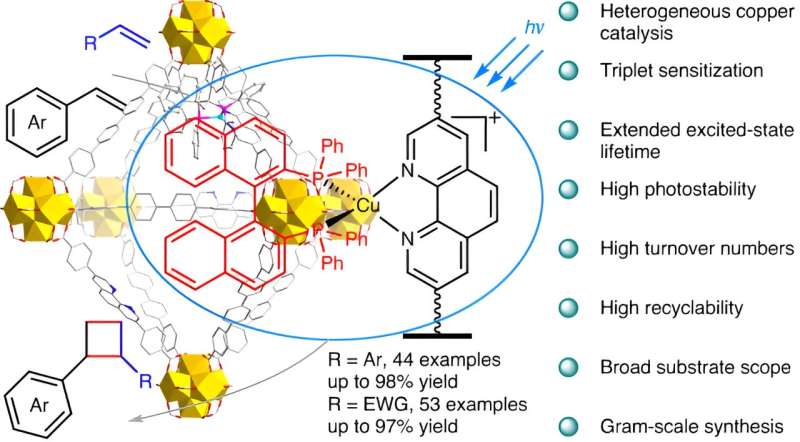This article has been reviewed according to Science X's editorial process and policies. Editors have highlighted the following attributes while ensuring the content's credibility:
fact-checked
trusted source
proofread
Heterogeneous copper photocatalysis for production of diverse bioactive compounds

Professor Jian He, from the Department of Chemistry at The University of Hong Kong (HKU), has spearheaded a research endeavor aimed at revolutionizing organic synthesis. His research team has successfully developed a novel heterogeneous copper photocatalyst that enables the efficient formation of cyclobutane rings, a crucial structural element in a vast array of bioactive molecules.
Cyclobutane rings are prominently featured in pharmaceuticals, natural products, and various biologically active compounds. By enabling researchers to construct these rings easily and selectively, Professor He's team has unlocked greater control over the synthesis of these vital molecules. The research findings have recently been published in Nature Catalysis.
In recent two decades, visible-light photocatalysts have been employed to drive such transformations through photochemical [2+2] cycloadditions; however, their substrate scope has been limited. Moreover, existing photocatalytic systems often rely on homogeneous precious metal catalysts, which pose challenges in catalyst recycling and hinder large-scale organic synthesis.
Addressing these limitations head-on, Professor He and his team have developed an innovative heterogeneous copper photocatalyst. This catalyst effectively facilitates energy-transfer processes for a range of intermolecular crossed [2+2] cycloadditions, including those previously inaccessible in conventional homogeneous photocatalysis. This new reaction system has excellent catalyst stability and recyclability, and it does not rely on precious metals, making it more economically and environmentally sustainable.
Professor He expressed great enthusiasm for the potential impact of this discovery, stating, "Our novel heterogeneous copper photocatalyst opens up new possibilities for synthesizing bioactive molecules with enhanced efficiency and selectivity. By eliminating the reliance on precious metals and improving catalyst recyclability, we have addressed critical challenges in large-scale organic synthesis, paving the way for more sustainable and economically viable chemical production."
Key findings
In this study, the team developed a special kind of copper photocatalyst that can help make cyclobutane molecules more efficiently. They successfully prepared a stable heterogeneous copper triplet photosensitizer by constructing binap-ligated heteroleptic copper(I) complexes in the pores of zirconium-based metal–organic frameworks (MOFs).
Upon heterogenization, reactive copper(I) species in photoexcited states show increased transition energies and lifetime, which is essential for boosting catalytic efficiency in energy-transfer-mediated [2+2] cycloadditions of styrenes with a variety of olefins, including electron-deficient alkenes.
Unlike the corresponding homogeneous copper photocatalysts, the MOF-supported copper photocatalyst exhibits high stability and catalytic activity, and can be recycled multiple runs without catalyst decomposition.
This work provides a general and interdisciplinary approach to designing highly reactive copper photocatalysts for a wide range of practical organic reactions, and it could help make the process of producing diverse bioactive compounds easier and more efficient in the future.
More information: Jun Guo et al, Visible light-mediated intermolecular crossed [2+2] cycloadditions using a MOF-supported copper triplet photosensitizer, Nature Catalysis (2024). DOI: 10.1038/s41929-024-01112-9
Provided by The University of Hong Kong





















